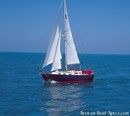Vancouver 28
Sailboat specifications
The Vancouver 28 is a 28’ (8.54m) cruising sailboat designed by Robert B Harris (United States). She was built between 1986 and 2005 by Northshore (United Kingdom) with 67 hulls completed.
Vancouver 28's main features
- Model
- Vancouver 28
- Hull type
- Monohull
- Category
- Offshore cruising sailboat
- Sailboat builder
- Sailboat designer
- Sailboat range
- Country
- United Kingdom
- Construction
- Hull and deck: GRP (glass reinforced polyester)
- Number of hulls built
- 67
- First built hull
- 1986
- Last built hull
- 2005
- Appendages
- Keel : swing keel
- Helm
- Single tiller
- Rudder
- Single transom hung rudder
- Unsinkable
- No
- Trailerable
- No
- Standard public price ex. VAT (indicative only)
- N/A €
Vancouver 28's main dimensions
- Hull length
- 28’8.54 m
- Waterline length
- 22’ 11”6.99 m
- Beam (width)
- 8’ 8”2.64 m
- Draft
- 4’ 4”1.3 m
- Light displacement (MLC)
- 8960 lb4064 kg
- Ballast weight
- 3450 lb1565 kg
- Ballast type
- Lead
Vancouver 28's rig and sails
- Upwind sail area
- 452 ft²42 m²
- Mainsail area
- 151 ft²14 m²
- Genoa area
- 301 ft²28 m²
- Yankee area
- 194 ft²18 m²
- Staysail area
- 86 ft²8 m²
- Rigging type
- Cutter Marconi masthead
- Mast configuration
- Deck stepped mast
- Rotating spars
- No
- Number of levels of spreaders
- 1
- Spreaders angle
- 0 °
- Spars construction
- Aluminum spars
- Standing rigging
- 1x19 strand wire continuous
Vancouver 28's performances
- Upwind sail area to displacementiThe ratio sail area to displacement is obtained by dividing the sail area by the boat's displaced volume to the power two-thirds.
The ratio sail area to displacement can be used to compare the relative sail plan of different sailboats no matter what their size.
Upwind: under 18 the ratio indicates a cruise oriented sailboat with limited performances especially in light wind, while over 25 it indicates a fast sailboat. - 177 ft²/T16.49 m²/T
- Displacement-length ratio (DLR)iThe Displacement Length Ratio (DLR) is a figure that points out the boat's weight compared to its waterline length. The DLR is obtained by dividing the boat's displacement in tons by the cube of one one-hundredth of the waterline length (in feet).
The DLR can be used to compare the relative mass of different sailboats no matter what their length:
a DLR less than 180 is indicative of a really light sailboat (race boat made for planning), while a DLR greater than 300 is indicative of a heavy cruising sailboat. - 337
- Ballast ratioiThe Ballast ratio is an indicator of stability; it is obtained by dividing the boat's displacement by the mass of the ballast. Since the stability depends also of the hull shapes and the position of the center of gravity, only the boats with similar ballast arrangements and hull shapes should be compared.
The higher the ballast ratio is, the greater is the stability. - 39 %
- Critical hull speediAs a ship moves in the water, it creates standing waves that oppose its movement. This effect increases dramatically the resistance when the boat reaches a speed-length ratio (speed-length ratio is the ratio between the speed in knots and the square root of the waterline length in feet) of about 1.2 (corresponding to a Froude Number of 0.35) . This very sharp rise in resistance, between speed-length ratio of 1.2 to 1.5, is insurmountable for heavy sailboats and so becomes an apparent barrier. This leads to the concept of "hull speed".
The hull speed is obtained by multiplying the square root of the waterline length (in feet) by 1.34. - 6.42 knots
Vancouver 28's auxiliary engine
- Engine(s)
- 1 inboard engine
Vancouver 28's accommodations and layout
- Cockpit
- Closed aft cockpit
- Cabin(s)
- 1
- Berth(s) (min./max.)
- 3 / 4
- Head(s)
- 1



Northshore Vancouver 28 sailplan - - 2/10
Picture extracted from the commercial documentation © Northshore
Picture extracted from the commercial documentation © Northshore


Northshore Vancouver 28 layout - - 3/10
Picture extracted from the commercial documentation © Northshore
Picture extracted from the commercial documentation © Northshore


Northshore Vancouver 28 layout - - 4/10
Picture extracted from the commercial documentation © Northshore
Picture extracted from the commercial documentation © Northshore


Northshore Vancouver 28 sailing - - 5/10
Picture extracted from the commercial documentation © Northshore
Picture extracted from the commercial documentation © Northshore


Northshore Vancouver 28 sailing - - 6/10
Picture extracted from the commercial documentation © Northshore
Picture extracted from the commercial documentation © Northshore


Northshore Vancouver 28 sailing - - 7/10
Picture extracted from the commercial documentation © Northshore
Picture extracted from the commercial documentation © Northshore


Northshore Vancouver 28 interior and accommodations - - 8/10
Picture extracted from the commercial documentation © Northshore
Picture extracted from the commercial documentation © Northshore


Northshore Vancouver 28 interior and accommodations - - 9/10
Picture extracted from the commercial documentation © Northshore
Picture extracted from the commercial documentation © Northshore


Northshore Vancouver 28 interior and accommodations - - 10/10
Picture extracted from the commercial documentation © Northshore
Picture extracted from the commercial documentation © Northshore
Similar sailboats that may interest you:
Sailboats
First built hull
Hull length
1966
33’ 5”10.18 m
1986
30’ 11”9.42 m
2007
32’ 8”9.97 m
1991
34’ 4”10.44 m
1978
26’ 2”7.98 m
1977
26’ 2”8 m
1972
31’ 2”9.5 m
1971
30’9.14 m
1971
26’ 10”8.18 m
1986
29’ 11”9.12 m
1984
27’ 1”8.25 m
1979
26’7.93 m
1981
29’ 6”9 m
1969
25’ 11”7.9 m
1967
33’ 1”10.1 m